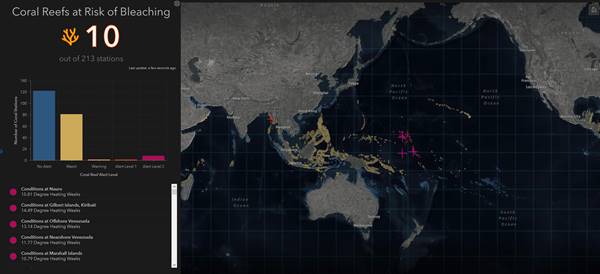On the calendar, there are days, weeks, and months that mark different interests and professions. March 3 is World Wildlife Day, World Environment Day is June 5, the first week of April is Public Health Week, the first week in November is Utility Week, late May marks Public Works Week, and June is National Safety Month. There are also days for very specific causes, such as the International Day for Mine Awareness on April 4.
These disciplines and causes—and many more—deploy a common tool: a geographic information system (GIS). GIS is used to gather data, make maps and apps, and analyze all inputs to inform a geographic understanding that guides actions—what needs to happen where.
This year, GIS Day takes place on Wednesday, November 13, and it's the twentieth anniversary of the event. GIS Day convenes practitioners at local events around the world to share outputs of work in the form of datasets, maps, apps, and reports. It provides an opportunity for peer-to-peer discussions and map centric poster presentations. It’s also a time to celebrate the GIS profession and educate and welcome new practitioners.
Why GIS?
Yes, GIS is a tool to make maps, but it spans nearly all disciplines because it provides a common platform to collect and communicate the location data that underpins evidence-based decision-making. Governments, businesses, academics, and nonprofits use GIS to collect, analyze, and visualize details about all aspects of their work.
GIS has evolved with the increased connectivity of the geospatial cloud and a broad stack of developer-accessible technologies that form a platform of geospatial infrastructure. Flexible and interconnected building blocks help organizations create purpose-driven applications and solutions that address complete workflows.
Modern GIS, with its suite of integrated tools, aggregates inputs from all participants to inform a shared awareness. This often involves the display of details on dashboards or community engagement websites to enhance collaboration around shared outcomes.
The science-driven language of GIS improves transparency, communication, engagement, and deliverability of actions and services toward set goals.
Tackling Problems of Today
Our world is increasingly dynamic, complex, and interconnected. We are challenged to understand and adjust to ever-changing social, political, economic, security, and environmental factors. This comes at a time of massive digital transformation with many new sensors and data streams and significant advances in computing. In this context, today's dynamism requires sustainable and innovative solutions¬ to overcome the challenges of tomorrow. The location intelligence that GIS provides is a key input to understand these challenge.
While GIS is about much more than a map, the Esri Map Gallery provides a good cross-section of the many industries and themes that GIS users tackle. Themes span infrastructure disciplines (water/wastewater, electric, telecommunications, transportation), natural resources (agriculture, forestry, mining, water resources), environmental management of parks and marine reserves, community development, city management, commercial applications in real estate, retail, insurance, supply chain management, and more.
Geographic information is a universal language that allows us to understand and interpret conditions, events, relationships, and patterns. Digital workflows ensure that this information keeps pace with our constantly changing world to collect and convey an up-to-date understanding. GIS Day provides a rallying point for this future forward work.
Taking Part in the Celebration
GIS Day has the support of Esri, the American Association of Geographers, and the National Geographic Society, and it is part of National Geographic's broader Geography Awareness Week.
Events on this day include open houses and map galleries at city and county governments, universities, libraries, and schools around the world. Interactive activities at these events emphasize the field capabilities of the toolset, rallying participants to collect data out on the landscape. Quizzes test geographic knowledge and provide a new perspective. Kids get a chance to explore their artistic side, creating maps and globes to take home. Conferences have been timed to coincide with the event, and there's even a technology carnival planned in Hong Kong.
GIS has become much easier to use and access, and it has become a part of everyday work. GIS rewards all who interact with it, from the diligent data gatherers to leaders who confront make-or-break decisions with the power of a geographic perspective.
By combining layers of place-based information, decision-makers hunting for insights are often rewarded with flashes of illumination—seeing what others can't see. If you haven't yet witnessed the power of GIS, be sure to take in local GIS Day activities to see it for yourself.

